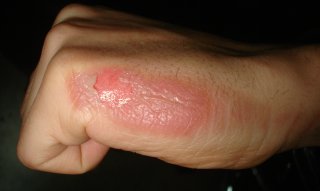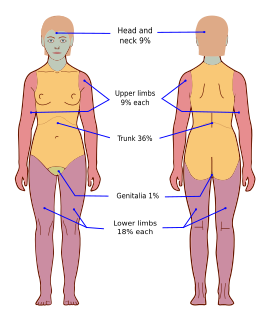
A burn is an injury to skin, or other tissues, caused by heat, cold, electricity, chemicals, friction, or ultraviolet radiation. Most burns are due to heat from hot liquids, solids, or fire. While rates are similar for males and females, the underlying causes often differ. Among women in some areas, risk is related to use of open cooking fires or unsafe cook stoves. Among men, risk is related to the work environments. Alcoholism and smoking are other risk factors. Burns can also occur as a result of self-harm or violence between people (assault).
Hemodynamics or haemodynamics are the dynamics of blood flow. The circulatory system is controlled by homeostatic mechanisms of autoregulation, just as hydraulic circuits are controlled by control systems. The hemodynamic response continuously monitors and adjusts to conditions in the body and its environment. Hemodynamics explains the physical laws that govern the flow of blood in the blood vessels.

Fluid replacement or fluid resuscitation is the medical practice of replenishing bodily fluid lost through sweating, bleeding, fluid shifts or other pathologic processes. Fluids can be replaced with oral rehydration therapy (drinking), intravenous therapy, rectally such as with a Murphy drip, or by hypodermoclysis, the direct injection of fluid into the subcutaneous tissue. Fluids administered by the oral and hypodermic routes are absorbed more slowly than those given intravenously.

Internal bleeding is a loss of blood from a blood vessel that collects inside the body. Internal bleeding is usually not visible from the outside. It is a serious medical emergency but the extent of severity depends on bleeding rate and location of the bleeding. Severe internal bleeding into the chest, abdomen, retroperitoneal space, pelvis, and thighs can cause hemorrhagic shock or death if proper medical treatment is not received quickly. Internal bleeding is a medical emergency and should be treated immediately by medical professionals.

Parkland Memorial Hospital is a hospital in Dallas, Texas, United States. It is the main hospital of the Parkland Health & Hospital System and serves as Dallas County's public hospital. It is located within the Southwestern Medical District. The hospital is staffed by the faculty, residents, and medical students of UT Southwestern Medical Center.
Charles Rufus Baxter was an American doctor. Baxter was one of the doctors who unsuccessfully tried to save U.S. President John F. Kennedy after he was shot in Dallas, Texas, in 1963. He is also remembered for the Parkland formula, which gives an indication of how much fluid should be given to a patient with burns.

A hemothorax is an accumulation of blood within the pleural cavity. The symptoms of a hemothorax may include chest pain and difficulty breathing, while the clinical signs may include reduced breath sounds on the affected side and a rapid heart rate. Hemothoraces are usually caused by an injury, but they may occur spontaneously due to cancer invading the pleural cavity, as a result of a blood clotting disorder, as an unusual manifestation of endometriosis, in response to a collapsed lung, or rarely in association with other conditions.

Crush syndrome is a medical condition characterized by major shock and kidney failure after a crushing injury to skeletal muscle. Crush injury is compression of the arms, legs, or other parts of the body that causes muscle swelling and/or neurological disturbances in the affected areas of the body, while crush syndrome is localized crush injury with systemic manifestations. Cases occur commonly in catastrophes such as earthquakes, to individuals that have been trapped under fallen or moving masonry.

A pericardial effusion is an abnormal accumulation of fluid in the pericardial cavity. The pericardium is a two-part membrane surrounding the heart: the outer fibrous connective membrane and an inner two-layered serous membrane. The two layers of the serous membrane enclose the pericardial cavity between them. This pericardial space contains a small amount of pericardial fluid. The fluid is normally 15-50 mL in volume. The pericardium, specifically the pericardial fluid provides lubrication, maintains the anatomic position of the heart in the chest, and also serves as a barrier to protect the heart from infection and inflammation in adjacent tissues and organs.

In thoracic surgery, a pulmonary thromboendarterectomy (PTE), also referred to as pulmonary endarterectomy (PEA), is an operation that removes organized clotted blood (thrombus) from the pulmonary arteries, which supply blood to the lungs.

Neurocritical care is a medical field that treats life-threatening diseases of the nervous system and identifies, prevents/treats secondary brain injury.
Oliver Cope, was an American surgeon known for his work in parathyroid surgery, burns treatment and breast cancer treatment. He is also remembered for describing the Churchill-Cope reflex.

The management of dehydration typically involves the use of oral rehydration solution (ORS). Standard home solutions such as salted rice water, salted yogurt drinks, vegetable and chicken soups with salt can be given. Home solutions such as water in which cereal has been cooked, unsalted soup, green coconut water, weak tea (unsweetened), and unsweetened fresh fruit juices can have from half a teaspoon to full teaspoon of salt added per liter. Clean plain water can also be one of several fluids given. There are commercial solutions such as Pedialyte, and relief agencies such as UNICEF widely distribute packets of salts and sugar. The World Health Organization (WHO) describes a homemade ORS with one liter water with one teaspoon salt and six teaspoons sugar added. The WHO; however, does not generally recommend homemade solutions as how to make them is easily forgotten. Rehydration Project recommends adding the same amount of sugar but only one-half a teaspoon of salt, stating that this more dilute approach is less risky with very little loss of effectiveness. Both agree that drinks with too much sugar or salt can make dehydration worse.

Alexander Burns Wallace (1906–1974) was a Scottish plastic surgeon. He was a founding member and president (1951) of the British Association of Plastic Surgeons, and the first editor of the British Journal of Plastic Surgery. In authorship he appears as A. B. Wallace.

The Wallace rule of nines is a tool used in pre-hospital and emergency medicine to estimate the total body surface area (BSA) affected by a burn. In addition to determining burn severity, the measurement of burn surface area is important for estimating patients' fluid requirements and determining hospital admission criteria.
quantium Medical Cardiac Output (qCO) uses impedance cardiography in a simple, continuous, and non-invasive way to estimate the cardiac output (CO) and other hemodynamic parameters such as the stroke volume (SV) and cardiac index (CI). The CO estimated by the qCO monitor is referred to as the "qCO". The impedance plethysmography allows determining changes in volume of the body tissues based on the measurement of the electric impedance at the body surface.
Endovascular and hybrid trauma and bleeding management is a new and rapidly evolving concept within medical healthcare and endovascular resuscitation. It involves early multidisciplinary evaluation and management of hemodynamically unstable patients with traumatic injuries as well as being a bridge to definitive treatment. It has recently been shown that the EVTM concept may also be applied to non-traumatic hemodynamically unstable patients.
A pediatric burn is an injury to the skin or underlying tissue in person under the age of 18, and is globally the most common type of pediatric injury. Burns can be caused my heat, cold, chemical or irritation. Most burns do not require hospital admission but a small percentage are serious and need to be transferred to specialist burn centers, where a multidisciplinary team of specially trained doctors, including surgeons and anesthesiologists can care for the child. Mortality rates at centers like this at are recorded at 3 %.
Retrograde autologous priming (RAP) is a means to effectively and safely restrict the hemodilution caused by the direct homologous blood transfusion and reduce the blood transfusion requirements during cardiac surgery. It is also generally considered a blood conservation method used in most patients during the cardiopulmonary bypass (CPB). The processing of RAP includes three main steps, and the entire procedure of RAP could be completed within 5 to 8 minutes. This technique is proposed by Panico in 1960 for the first time and restated by Rosengart in 1998 to eliminate or reduce the risk of hemodilution during CPB. Moreover, to precisely determine the clinical efficacy of RAP, many related studies were conducted. Most results of researches indicate that RAP is available to provide some benefits to reducing the requirements for red blood cell transfusion. However, there are still some studies showing a failure of RAP to limit the hemodilution after the open heart operation.
Ian Fraser Muir MBE, FRCS, FRCSEd was an English plastic surgeon at the West Middlesex Hospital and Mount Vernon Centre for Plastic Surgery. While working there he developed what became known as the 'Muir and Barclay formula' which estimates the volume of fluid replacement required in the initial resuscitation after major burns. In 1969, he relocated to Aberdeen to set up the plastic surgery and burns unit, having been appointed plastic surgeon and senior lecturer in Surgery at the University of Aberdeen. He was elected president of the British Association of Plastic Surgeons











